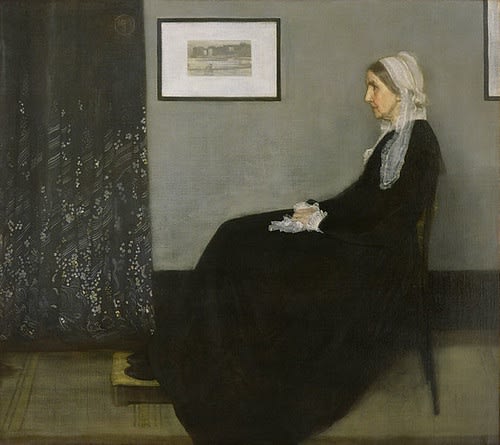Alex Katz’s recent retrospective at the Guggenheim began with a portrait of his mother, Sima Katz. He painted the work in 1946, when he was 19 years old, just beginning his study of painting at Cooper Union. Sima was an actress, born in Russia and a star of the Yiddish theatre.
Julia Warhola, the mother of Andy Warhol, lived in the basement apartment of the artist’s Manhattan townhouse from 1951 to 1971. An artist herself, Julia calligraphed many of his works and even won an award from American Institute of Graphic Arts for an album cover design. Julia encouraged her son’s artistic endeavors from the time he was a young boy and continued to feed and care for him during most of his life.
When Jean-Michel Basquiat was just seven years old, he was playing in the street outside of his Brooklyn home, when he was hit by a car. He suffered a broken arm and internal injuries. During his recovery, his mother, Matilda Andrades Basquiat, gave him a copy of Gray’s Anatomy and drawing materials, a gift that informed his work for the rest of his life. Matilda also took him to museums and signed him up for junior membership of the Brooklyn Museum of Art.
Mary Cassatt was born into a wealthy family in Pennsylvania. The family traveled extensively and Cassatt was inspired to become an artist. Over her family’s objections, she moved to Paris in 1866. Her mother, Katherine Kelso Johnston, acted as her chaperone. At that time, women were not allowed to attend the École des Beaux-Arts, not allowed to attend figure drawing classes that used nude models and were not allowed into cafes unless escorted by a male companion. Cassatt overcame the restrictions by painting women, especially mothers and children, in her studio. One of her finest paintings Reading "Le Figaro" is a portrait of Katherine reading the newspaper.
James Abbott McNeill Whistler (1834-1903) was born in Massachusetts, and traveled through Europe with his family. Whistler had a reputation as a 'bad boy'. He was kicked out of West Point for bad behavior, went to Paris in 1855 to study art and eventually settled in London.
His very religious, very proper mother, Anna, visited him in London in 1864 and put a damper on his bohemian life style. By then, Whistler had been experimenting with color and line and his love of music led him to name his paintings after musical compositions.
According to a letter written by Anna, one of Whistler’s models didn’t show up for a painting session, so she became his model. She became too tired to stand and pose, so Whistler sat her in a chair. He called the finished portrait Arrangement in Grey and Black No.1. (Arrangement in Grey and Black No.2 is a portrait of British historian, Thomas Carlyle).
The painting was a critical flop because of its flaunting the prevalent Victorian style of the day, but a great success when shown at the 1933 Chicago World’s Fair. Today, the painting of Whistler’s Mother hangs in the Musée d’Orsay in Paris and is one of the most iconic paintings in the world.
Happy Mother’s Day to all those who encourage their children to let their imaginations soar and to color outside of the lines.






